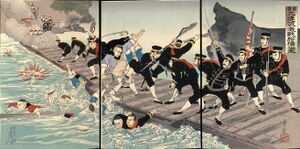معركة جيوليانتشنگ
| معركة جيوليانتشنگ Battle of Jiuliancheng | |||||||
|---|---|---|---|---|---|---|---|
| جزء من الحرب الصينية اليابانية الأولى | |||||||
 القتال حامي الوطيس على الجسر الطافي في جيوليانتشنگ، فوكوشيما توشيميتسو | |||||||
| |||||||
| المتحاربون | |||||||
|
|
| ||||||
| القادة والزعماء | |||||||
|
|
| ||||||
| القوى | |||||||
| 13,000 | 20,000 | ||||||
| الضحايا والخسائر | |||||||
|
4 قتلى 140 جريح | 2,000 قتيل | ||||||
معركة جيوليانتشنگ (九連城之戰 ؛ Battle of Jiuliancheng) كانت معركة برية في الحرب الصينية اليابانية الأولى بين قوات يابان مـِيْجي و صين تشينگ. وأحياناً يشار لها بإسم معركة نهر يالو (鴨緑江作戦, Ōryōkuko Saksuken)، مما تسبب في لبسٍ مع النزاع البحري السابق بنفس الاسم في 17 سبتمبر، والمعارك البحرية والبرية اللاحقة في الحرب الروسية اليابانية، بنفس الاسم والذي نشب في نفس الموقع.
. . . . . . . . . . . . . . . . . . . . . . . . . . . . . . . . . . . . . . . . . . . . . . . . . . . . . . . . . . . . . . . . . . . . . . . . . . . . . . . . . . . . . . . . . . . . . . . . . . . . . . . . . . . . . . . . . . . . . . . . . . . . . . . . . . . . . . . . . . . . . . . . . . . . . . . . . . . . . . . . . . . . . . . .
الخلفية
بعد هزيمتهم في معركة پيونگ يانگ, the Beiyang Army made its next stand at the crossing of the Yalu River, the border between Korea and China. On the Chinese side, Qing general Song Qing established his headquarters at the walled town of جيوليانتشنگ (九連城), and fortified the banks of the Yalu River south to the local district capital of Dandong and north to the village of Hushan (虎山) for about 16 kilometers in either direction with over a hundred redoubts and trenches manned by around 23,000 troops.[1]
On the Korean side of the Yalu River, Japanese general Yamagata Aritomo occupied the walled town of Uiju on 23 October 1894 with approximately 10,000 troops of the Japanese First Army, consisting of the 3rd and 5th Divisions. Although Yamagata and the main Japanese force did not arrive until 23 October, Japanese scouts and engineers had been present since early that month, surveying the river and laying a telegraph line to Pyongyang.[2]
المعركة
Yamagata's strategy was to feint a frontal assault on the main Beiyang Army positions في جيوليانتشنگ، while his main forces turned the Chinese flank at Hushan. During the night of 24 October, the Japanese succeeded in placing a pontoon bridge over the Yalu River undetected, immediately in front of the Chinese fortifications. The IJA 3rd Division under General Katsura Tarō staged a night attack on Hushan on 25 October 1894, only to discover that the bulk of the Chinese garrison had deserted their fortifications the night before. Likewise, the IJA 5th Division under General Nozu Michitsura, upon crossing إلى جيوليانتشنگ، found positions deserted, with only a rear guard making a token resistance. After less than three hours, the fortifications of both Jiuliancheng and Hushan were in Japanese hands.[1]
Likewise, Dadong was occupied the following day without resistance, with the Beiyang Army leaving behind large quantities of weapons and supplies.
الأعقاب
A provisional Japanese civilian administration led by Baron Komura Jutarō (and later succeeded by Lieutenant General Fukushima Yasumasa) was established in the areas of the Liaodong Peninsula which came under Japanese control.
The Japanese First Army was divided into two groups. One group, commanded by Lieutenant General Katsura Tarō pursued the fleeing Antung garrison (which included General Nie Shicheng) north to Fenghaungcheng, which fell to the Japanese on 30 October, and to Xiuyan to the west of Fenghaungcheng, which was captured on 15 November. This served to isolate the land approaches to the strategic port of Lüshunkou (Port Arthur).[1]
The second group under Lieutenant General Oku Yasukata marched north under severe winter conditions to threaten the centre of Fengtian Prefecture, Mukden. General Song and the garrison of Jiuliancheng occupied Liaoyang on the road to Mukden to block the Japanese advance, and both armies went into winter quarters.
المراجع
الهامش
- ^ أ ب ت Paine 2003, pp. 188–203.
- ^ http://sinojapanesewar.com/invasionofChina.htm
ببليوگرافيا
- Elleman, Bruce A (2001). Modern Chinese Warfare, 1795–1989. Routledge. ISBN 0-415-21473-4.
- Jowett, Philip (2013). China's Wars: Rousing the Dragon 1894-1949. Bloomsbury Publishing. ISBN 978-1-47280-673-4.
- Olender, Piotr (2014). Sino-Japanese Naval War 1894–1895. MMPBooks. ISBN 978-83-63678-30-2.
- Paine, S.C.M (2003). The Sino-Japanese War of 1894–1895: Perceptions, Power, and Primacy. Cambridge University Press. ISBN 0-521-81714-5.
للاستزادة
- Chamberlin, William Henry. Japan Over Asia, 1937, Little, Brown, and Company, Boston, 395 pp.
- Kodansha Japan An Illustrated Encyclopedia, 1993, Kodansha Press, Tokyo ISBN 4-06-205938-X
- Lone, Stewart. Japan's First Modern War: Army and Society in the Conflict with China, 1894–1895, 1994, St. Martin's Press, New York, 222 pp.
- Warner, Dennis and Peggy. The Tide At Sunrise, 1974, Charterhouse, New York, 659 pp.